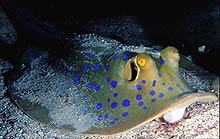Sensory biology
As the majority of rays are bottom dwellers, their mouths are located on the under-surface of the disc and although they have good vision (colour vision in at least some species), this means that rays often cannot see what they are eating. To find their prey without vision, they have developed a number of other sensory systems.
These systems include an ability to ‘touch’ things from a distance by using their lateral line systems to detect minute water currents, an acute sense of hearing and the ability to detect one drop of fish extract in 10 billion drops of water. Rays also possess another sense that is quite alien to humans.
Organs, known as the ampullae of Lorenzini, are clustered around the head and mouths of rays. These organs can detect weak electric signals created by muscles and nerves in potential prey.
Rays perceive these signals as an ‘aura’ around the animal. In combination, these senses mean that rays are very good at detecting prey hidden under the mud or sand of the sea floor. |

This bluespot fantail ray (Taeniura lymma )
is commonly encountered on and around
coral reefs. Coral sand, thrown up
during ‘pit-digging’ can be seen
on the back of the ray. The
protruded jaws are visible under
the animal as the ray feeds.
(© Andrea Marshall)
|
